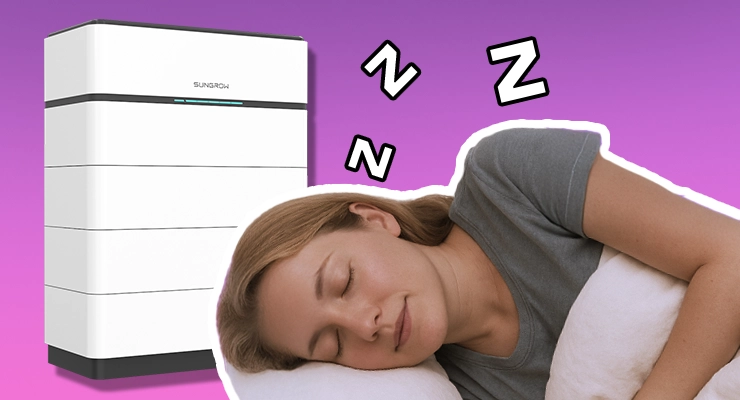Fast read
Modern home solar batteries are exceptionally quiet, operating at levels similar to a refrigerator. The battery cells are silent; noise typically comes from supporting components like inverters and cooling systems. Careful product selection and thoughtful placement can ensure your energy storage system is barely noticeable.
Do home solar batteries make any noise?
As Australian households increasingly embrace renewable energy, one of the most common questions we hear at Your Energy Answers centres on the practicalities of living with the technology. You’ve decided on solar panels, but what about the battery? It’s a fair and important question: Will this new addition to your home introduce a constant, annoying hum?
The short answer is overwhelmingly positive. Battery technology has advanced to a point where noise is rarely a concern. However, understanding what can make noise and why will empower you to make the best choices for a peaceful, energy-independent home.
Why would a battery system make any noise?
It’s a common misconception that the battery itself is the source of noise. In reality, the electrochemical cells that store energy are completely silent. The sounds associated with a home energy storage system almost always come from two key components:
- The Inverter: This is the brain of your solar system, converting the Direct Current (DC) electricity from your solar panels and battery into the Alternating Current (AC) that your home appliances use. This conversion process can sometimes produce a very faint, low-level hum or buzzing sound, especially during peak operation.
- The Cooling System: Like any hardworking piece of electronics, battery systems and inverters need to stay within an optimal temperature range to perform efficiently and safely. To do this, they use cooling systems. These can be passive (using heat sinks to dissipate heat silently) or active (using small internal or external fans). On hot days or when the battery is charging or discharging rapidly, these fans may spin up, creating a soft whirring sound.
How much noise are we talking about?
For context, a quiet library sits at around 30 decibels (dB), a refrigerator hums along at about 40 dB, and a normal conversation is roughly 60 dB.
Most modern solar battery systems are engineered for quiet operation, with noise levels typically falling between 25 and 50 dB. This means that under normal conditions, the sound is comparable to a soft whisper or the ambient noise of a quiet room.
For example:
- Enphase highlights that its batteries use passive cooling without fans, making them exceptionally quiet.
- Sungrow specifies noise levels for its popular hybrid inverters in the range of 35-45 dB, a level quieter than a typical conversation.
- Tesla’s Powerwall 3 has a typical operating noise level below 50 dB, but its datasheet notes a maximum noise level of less than 62 dB(A) when its cooling system is working at full capacity. This is closer to the volume of a normal conversation.
- The all-in-one Sigenergy SigenStor system features a very quiet, fanless inverter rated at 25 dB. However, it’s important to note that other components in the complete system can be rated higher, up to <45 dB, depending on the specific configuration and operating conditions.
It is important to check the manufacturer’s datasheet for the specific model you are considering, as this will provide its official noise rating in decibels.
Factors that can influence noise levels
While modern systems are quiet, a few factors can affect how much noise you perceive:
- System Workload: The harder your system is working—for example, charging from a large solar array on a very sunny day or discharging power to run multiple high-power appliances at once—the more likely the cooling fans are to activate.
- Ambient Temperature: On extremely hot Australian summer days, the cooling systems in both the inverter and battery will naturally work harder to maintain safe operating temperatures, which can temporarily increase noise.
- Installation Quality: Proper installation is crucial. A unit that is not securely mounted can transmit vibrations into the wall, potentially amplifying the sound. Loose wiring or components can also be a source of rattling sounds.
What to do if you hear an unusual noise
A consistent, low-level hum is usually normal. However, if you ever hear loud buzzing, crackling, or grinding sounds, it could indicate a problem such as a faulty fan, loose wiring, or a component failure. In this situation, it is essential to contact your accredited installer for a professional inspection.
How to ensure a quiet solar battery installation
Peace of mind comes from making informed decisions from the start. Here are our expert tips for guaranteeing a quiet system:
- Ask the Right Questions: When getting quotes, ask your installer about the noise levels of the specific batteries and inverters they recommend. Ask for the official datasheets and compare the decibel ratings.
- Prioritise Quality Components: High-quality, modern inverters and batteries are generally designed to be quieter and more efficient.
- Strategic Placement: This is perhaps the most critical factor. Work with your installer to choose a location that minimises any potential sound impact. Garages, laundries, or insulated utility cupboards are excellent choices. Avoid installing units directly on walls adjoining bedrooms or quiet living spaces.
- Ensure Professional Installation: Always use an installer accredited by Solar Accreditation Australia (SAA). SAA is the new government-endorsed body for accrediting installers under the Small-scale Renewable Energy Scheme (SRES), having officially taken over this role from the Clean Energy Council (CEC) as of 29 February 2024. An SAA-accredited professional will ensure the unit is mounted securely to prevent vibration and that all components are installed according to manufacturer’s specifications and Australian standards.
By understanding the minimal noise produced by modern solar batteries and planning your installation thoughtfully, you can confidently invest in a clean energy future without disrupting the peace and quiet of your home.




